There’s a reason why people buy things. It is because the things people buy are appealing to the people who spend money on them.
That has been the secret of the Honda Civic’s success for the past 50 years.
Yes, it’s true – even if it makes you feel old (for those who already knew). The Civic came out in 1972 – which is actually more than 50 years ago – and since that time it has been perennially popular with car buyers. 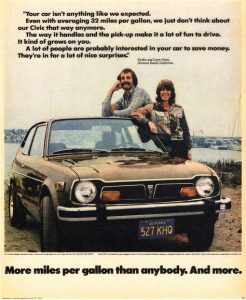
But why, specifically?
The answer is easy: The Civic meets buyers needs – and their wants. It is practical, efficient and affordable. It also comes in more than just one take-it-or-leave-it way.
And – most of all – it offers the kind of fun that’s becoming very hard to find in a practical, efficient and affordable small car anymore.
WHAT IT IS
The Civic is Honda’s entry level compact car. Unlike most of the others of its type, it’s available in sedan and five-door hatchback bodystyles. It is also available with three different engines – and two different transmissions.
Prices start at $23,450 for the LX sedan, which is equipped with a 2.0 liter four cylinder engine and a CVT automatic. The same basic thing – in a five-door hatchback – lists for $24,450.
The Sport trim stickers for $25,050 ($25,850 for the hatchback) with the same engine but you can pair it – in the hatchback – with a manual transmission.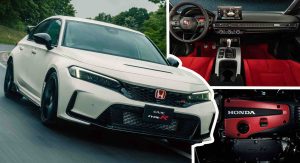
EX trims ($26,450 for the sedan, $28,150 for the hatch) come only with the CVT automatic but they both come standard with a stronger 1.5 liter turbocharged engine.
Touring trims ($30,050 for the sedan; $30,950 for the hatch) also comes standard with the 1.5 liter engine but the hatch iteration can be ordered with a manual.
The high-performance Si ($26,450) gets a stronger version of the 1.5 liter engine paired only with a manual transmission. This version of the Civic is also offered only in the sedan bodystyle.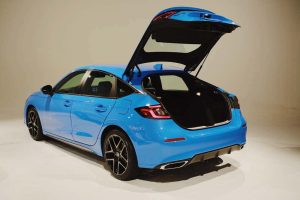
But if you want the hatch – and the strongest-available Civic engine – there’s a Type R iteration that’s also the priciest Civic at $43,295. This one also comes only with a manual transmission as well as flared fenders, a rear wing, high-capacity Brembo brakes, 19 inch wheels and tires and an adaptive suspension.
What’s New for 2023
The Type R variant returns to the roster.
What’s Good
More than just one Civic.
More than just one Civic engine.
More than just one Civic transmission.
What’s Not So Good
Not every engine – and transmission – is available with the kind of Civic you might prefer.
Every Civic comes standard with “advanced driver assistance technologies” many drivers don’t want.
Standard four speaker stereo could use two more speakers.
Unlike so many (of the not very many) small cars still left on the market, the Civic is not one-size-fits all.
That includes under the hood. It is the only entry-level small car that is available with three different engines (one of them in two different states of tune) and with more than just one – invariably automatic – transmission.
The base LX trim – sedan and hatch – come standard with a 2.0 liter four that isn’t turbocharged. It makes 158 horsepower and rates 31 city, 40 highway. This is the Civic’s economy engine – and for just that reason, it is paired with a continuously variable (CVT) automatic transmission. These transmissions are specifically designed for economy and usually yield a 2-3 MPG gain over a conventional automatic that shifts through gears (rather than varying the ranges) and vs. manuals. At least on government fuel economy tests.
It’s the reason why CVTs have become so common in the economy car (and crossover) class.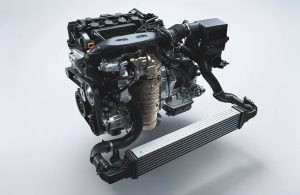
But if you prefer a little more action, you can pair the 2.0 engine with a manual – in the hatchback Sport trim. The city/highway figures dip to 26/36 – but that’s still very economical.
If you prefer more scoot, the 1.5 liter engine might just suit. This smaller engine is fitted with a turbocharger – which enables it to make more horsepower (180) without using more gas. In fact, this engine uses less gas. Paired with the CVT (in the sedan) it rates 33 city, 42 highway; even when paired with the six speed manual (in the hatch) it rates 28 city, 37 highway.
More scoot?
The Si gets a more powerful (200 hp) version of the 1.5 liter engine. Paired with the standard six speed manual, this one returns the same 28 city, 37 highway – while also cutting down the Civic’s 0-60 time to 6.7 seconds. That’s about two seconds quicker than the base LX with the non-turbo 2.0 engine and the CVT automatic.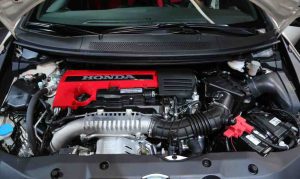
Finally – ultimately – there is the Type R. This one reverts to the larger 2.0 liter engine, but heavily modified (and turbocharged). It summons 315 horsepower, making it one of the highest-output-per-liter engines ever offered. As with the Si, the Type R is a manual only deal. Unlike the Si – which comes only in sedan form – the Type R comes only in hatchback form. In other words, the most powerful Civic is also pretty practical.
It is also the quickest.
A Type R can get to 60 in five seconds – making it (by far) the quickest Civic Honda has ever offered.
And it still manages 22 city, 28 highway.
The Civic’s drivetrains – plural – give it multiple personalities. Not in the psychiatric sense but rather the good sense.
The base LX with the 2.0 and CVT is what Civics have always been – an inexpensive, economical and pleasant way to get around. It’s a great choice for a first car or a commuter car.
The hatchback version is also a pretty practical car for young singles – and couples, too.
The Sport hatch with the manual is more of what the Civic was in that you can have some real fun driving this one because it’s fun to shift for yourself, especially in an economy car. It makes such a car feel quicker than it is and it gives you something (fun) to do while you’re driving. Honda’s manuals are particularly fun because of the tight shift-action and the very traffic-friendly (not grabby) clutch.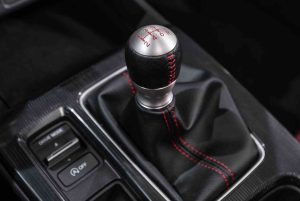
The Sport – with the manual – would have been considered a “hot hatch” if this were 1983 rather than 2023. It isn’t considered that today because there are hotter hatches – like the Civic with the optional 1.5 turbo engine and the manual. The Si – with the 200 hp version – would have been considered an exotic high-performance hatch back in ’83. Back then, 200 horsepower was Corvette V8 power.
Time works wonders.
But don’t overlook the Sport Touring Civic with the 180 hp version of the 1.5 liter turbo engine. It’s almost as quick and feels as responsive and it is a hatchback. The Si sedan isn’t. True, the latter has another 20 horsepower – but it also has a small (12.4 cubic foot) trunk that detracts from its practicality. It’s a lot easier to recover 20 horsepower – a flash-tune would likely get ‘er done – than it is to convert a trunk to a hatch with a Sawzall and some Bondo. Plus, the Sport Touring is likely to cost less to insure than the Si – especially if you’re under 30.
Running under the radar is just as helpful to your finances as having a radar detector.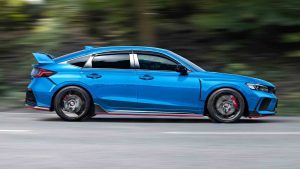
The Si does offer more than just 20 more horses, of course.
The suspension is noticeably firmer – which you may like or not – and the manual comes with a rev-matching downshift function. The latter is kind of like the launch control systems many new performance cars tout in that it does what many drivers haven’t learned how to do. In this case, the fancy footwork involved in “blipping” the accelerator while operating the clutch and timing your shift just right. It’s quite something to have the car do this but it’s also losing something. Part of the fun of driving a high-performance car being the knowing-how-to.
And learning how to.
Then there’s the Type R. This thing has its very own personality, just as Mr. Hyde did. But it’s also Dr. Jekyll in that despite what it can do (like Mr. Hyde) it is a remarkably amiable car that can be driven comfortably in stop-and-go traffic. And then, when it’s time to go . . .
One of the appeals of the Civic is that it appeals to more people.
Some people prefer a sedan – and the lower buy-in cost (you can save $1,000 buying the LX sedan vs. the LX hatch). Others prefer the hatchback layout because it makes the most of the space available, which in the case of a small car is no small thing
The sedan has a 14.8 cubic foot trunk. This isn’t small for a small car. In fact, it’s almost as big as some mid-sized cars’ trunks. It’s adequate for a commuter car but doesn’t really work for getting a sofa home – or to college. The hatch, on the other hand, has 24.5 cubic feet of space.
A trunk only opens so wide. A hatch opens higher – and longer. It extends much farther into the roofline and – when open – so is the entirely of the car’s interior. You might not get the whole sofa in there. But probably enough to strap the rest down – and get it home.
Either way, you get analog-style gauges (excepting the Type R) rather than smartphone-style “displays.” There is an iPad style touchscreen sprouting from the dashtop but there are also hand-friendly knobs to adjust temperature, fan speed and so on. An interesting feature are the aircraft-style toggle vents that allow for more precise directional control of the airflow.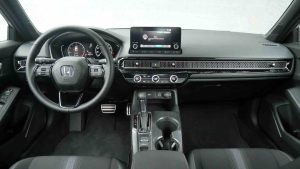
Honda has also not eliminated (or hidden) the 12V power point, as many other car brands have. Not having a place to easily plug in accessories that use 12V pigtails (such as many radar detectors) is a definite detraction. One you won’t fine here.
Automatic-equipped Civics have their gear selector offset-mounted on the driver’s side of the center console; manual-equipped Si (and Type R) models get Honda’s wonderfully tactile (and short-throw) stubby shifter.
Both the sedan and the hatch have full-size car legroom (42.3 inches) up front and mid-sized car legroom (37.4 inches) in the back. These facts make this small car as comfortable for four to ride in as many larger cars. (You can fit five – three in back, two up front – but not so comfortably for those in back – as is true of every new car, whether small or large.)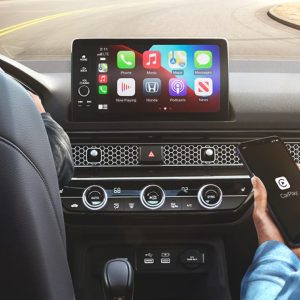
The Civic also has something else that many others – irrespective of size – are lacking and that is a clear view to either side. The Civic’s door tops aren’t as high as many others – because Honda worked to meet side-impact standards the harder way, by figuring out how to strengthen the structure without just adding more metal to the top part. Thus, you have more glass area.
Thus, you can see more of what’s on either side of you.
Arguably, this is of more value than “advanced driver assistance technology” – which has become ubiquitous – in part – because so many new cars have such poor outward (and rearward) visibility.
The Rest
All trims come with push-button ignition (and transmitter fob) rather than a key. This is in keeping with trends, but some may miss being able to get a replacement key cut for less than $10 at any hardware store vs. dealing with a replacement fob that must be programmed – that often costs a great deal more than $10.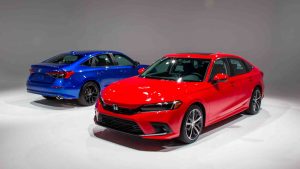
The standard four speaker stereo is ok.
Unfortunately, you can’t opt for a better one – without moving up to the Sport (or higher) trims. But this isn’t really a big deal as it is very easy to add speakers (and better speakers) via the aftermarket.
The Bottom Line
The Civic remains popular even as the popularity of small cars has waned. Probably there’s a reason for that.
. . .
If you like what you’ve found here please consider supporting EPautos.
We depend on you to keep the wheels turning!
Our donate button is here.
If you prefer not to use PayPal, our mailing address is:
EPautos
721 Hummingbird Lane SE
Copper Hill, VA 24079
PS: Get an EPautos magnet or sticker or coaster in return for a $20 or more one-time donation or a $10 or more monthly recurring donation. (Please be sure to tell us you want a magnet or sticker or coaster – and also, provide an address, so we know where to mail the thing!)
If you like items like the Keeeeeeeeev! t shirt pictured below, you can find that and more at the EPautos store!



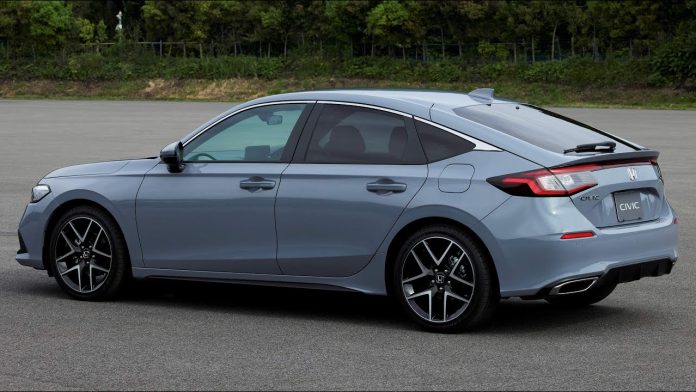



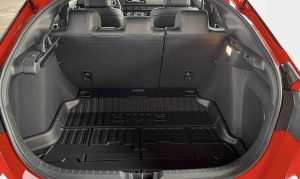
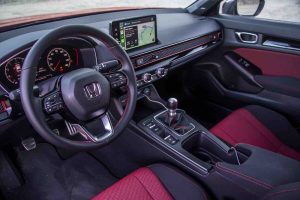







In 2021 I made a huge deal about finding a used 2019 Civic coupe in the EX trim *and* the right color (blue, duh), and it was the most disappointing car I’ve ever owned. It underperformed as my airporter, with disappointing fuel economy–less than 30 mpg, if I recall, and that was with 98% of the miles on the interstate. It handled okay for what it was (not my M3) and it was reasonably peppy, but it was nowhere close to being as well-made as I’d expected. It squeaked and rattled and the plastic inside shook…Just really disappointing in every respect. It was just two years old when I got it and I really expected to have it for years, but I couldn’t stand it. I was thrilled to trade in for a 2011 F150 (blue), which has been not only more useful now that I’m retired but more satisfying to drive. I can excuse a few rattles in a 12 year-old truck, but not in a 2 year-old Honda. I’ve always been a little sorry to get rid of my cars, but not that Civic. It sucked.
Interesting take, Paula.
An affordable car that gets 31 city, 40 highway?
Do you hate the earth? This car will kill us all.
Biden will fix that.
‘The Civic came out in 1972 – which is actually more than 50 years ago.’ — eric
Thus, Honda’s Civic is approaching the production longevity of the legendary Volkswagen. And the Toyota Corolla, Honda Accord, and Mazda Miata MX-5 are not that far behind.
Why can’t US manufacturers pull this off? In 1972, American cars such as the Chevrolet Impala, Ford Galaxie, and Plymouth Barracuda — hell, even Checker Cab — sported a commanding brand image. But that’s all over. Ford’s Maverick of that era is now a car-based pickup. And the iconic Mustang label has been irrevocably polluted by applying it to an obese EeeVee, rolling on a stupid skate.
Not only did Japanese makers begin whipping their US counterparts’ asses in the 1970s with better quality, they carried on upping the ante by establishing brand niches that just WON’T FADE AWAY. Kaizen, bitches.
As a de facto production arm of the US fedgov, the deracinated US auto industry can’t even get the basics right. #FAIL #LOSERS #CHAPTER 11 ALL OVER AGAIN #WHO CARES
Hello Jim, I reckon its because car manufacturers in America focus only in their domestic market. I am yet to see a Lincoln, Cadillac or a Buic prowling the streets of say, Kampala or Mumbai, whereas you find Corollas, Civics and Mazdas in nearly all corners of the world. The wider market ensures continued demand of a particular model especially if it was appreciated to be of good quality.
The Civic Sport 6 speed manual and the VW Jetta Sport 6 speed manual both strike me as being nearly perfect cars for the price. Quick, fun, spacious, comfortable, cheap and very fuel efficient. If only there’s a way to defeat the spying telemetry and electronic safety nannies. There’s got to be a way to defeat these things.
I wish that small cars either offered manual transmissions more, or at least offered geared automatics. A great solution would be a DCT! A DCT can allow paddle shifters, so you can control gear selection when you want, but it can also go back to full auto mode. Since Honda has experience with DCTs, I’m curious as to why they didn’t offer them with the Civic; it would’ve been a far more appealing option than the CVT.
Hi Mark,
My guess as regards the DCT thing is the cost. Also, feel. Many people apparently dislike the way DCTs feel (vs. conventional automatics and CVTs) during low-speed/part-throttle operation. Conventional automatics and CVTs are smoother. Not always. But generally.
I’m just happy the manual is still available!
The delivery service just dropped off a new Crosstrek – which is now automatic (CVT) only….
I know folks don’t like DCTs; I think that’s why Ford never offered another one after discontinuing the Focus and Fiesta. As a Focus owner, I like the DCT. Is it different? Yes, but once you get used to it, it’s all good. I like a DCT because it offers the best of both worlds: you can change gears when you want to, and you can let the tranny do the work when you don’t want to, like in traffic. They’re also very economical. I have arthritic knees, and at times they act up to the point where operating a true manual would be painful. With the DCT, I have have the best of BOTH worlds!
Every car I’ve driven with paddle shifters is a lame imitiation of the Pole Position video game. They are crap and I’m not fooled by car salesmen who say “it’s just like a manual” it has manual like features or some such rot.
Paddle shifters are stupid.
Hi Swamp,
Yup. The only automatics that don’t suck are those that have full manual valve bodies. These allow you to control when the transmission up (and down) shifts. There is no “programming” to override you. I have such a one in my Trans-Am.
They’re NOT stupid to those of us with bad knees who are unable to operate a clutch! It’s better than nothing.